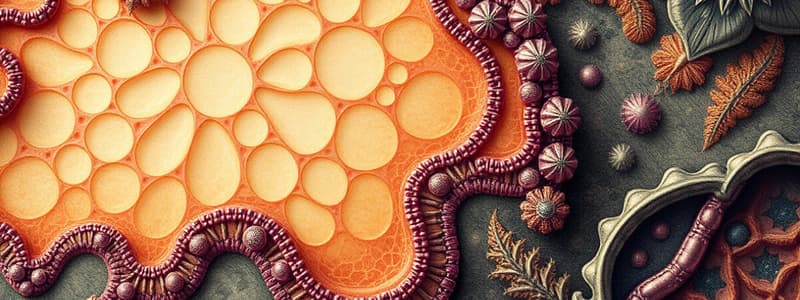Podcast
Questions and Answers
What is a primary function of epithelial tissue?
What is a primary function of epithelial tissue?
- Facilitate communication between body parts
- Store energy in the form of fat
- Support and protect organs
- Absorb nutrients and secretes substances (correct)
Which of the following correctly distinguishes between endocrine and exocrine glands?
Which of the following correctly distinguishes between endocrine and exocrine glands?
- Endocrine glands are located only in the brain; exocrine glands are found throughout the body.
- Endocrine glands are primarily involved in digestion; exocrine glands regulate metabolic processes.
- Endocrine glands are multicellular structures; exocrine glands are always unicellular.
- Endocrine glands secrete hormones directly into the bloodstream; exocrine glands have ducts. (correct)
Which of the following is NOT a type of epithelial tissue?
Which of the following is NOT a type of epithelial tissue?
- Squamous epithelium
- Cuboidal epithelium
- Columnar epithelium
- Adipose epithelium (correct)
Which connective tissue subtype is primarily characterized by a fluid matrix?
Which connective tissue subtype is primarily characterized by a fluid matrix?
What type of muscle tissue is both voluntary and striated?
What type of muscle tissue is both voluntary and striated?
Which structure of a neuron is primarily responsible for receiving signals from other neurons?
Which structure of a neuron is primarily responsible for receiving signals from other neurons?
Flashcards are hidden until you start studying
Study Notes
Major Functional Differences Among Tissue Types
- Four primary tissue types: epithelial, connective, muscle, nervous.
- Epithelial Tissue: Protection, absorption, secretion, sensation.
- Connective Tissue: Support, binding other tissues, storing energy, transporting substances.
- Muscle Tissue: Movement through contraction, includes skeletal, cardiac, and smooth muscle.
- Nervous Tissue: Transmits electrical impulses, processes information, supports neurological functions.
Structure and Function of the 5 Types of Epithelia
- Simple Squamous: Thin, flat cells; allows for diffusion and filtration.
- Simple Cuboidal: Cube-shaped cells; functions in secretion and absorption (found in glands).
- Simple Columnar: Tall, column-like cells; absorbs nutrients and produces mucus.
- Stratified Squamous: Multiple layers of cells; provides protection against abrasion (skin).
- Pseudostratified Columnar: Appears layered due to varying cell heights; involved in secretion and movement of mucus.
Anatomical Organization of Epithelial Tissue
- Composed of closely packed cells, minimal extracellular matrix.
- Cells are polarized with an apical surface (exposed to environment) and a basal surface (attached to basement membrane).
- Basal lamina supports and anchors the epithelium to underlying connective tissue.
Structural and Functional Differences: Endocrine vs Exocrine Glands
- Endocrine Glands: Ductless; secrete hormones directly into the bloodstream, regulating various bodily functions.
- Exocrine Glands: Have ducts; secrete substances (e.g., enzymes, sweat) onto epithelial surfaces or into cavities.
Structure and Function of Glands
- Unicellular Glands: Single-celled (e.g., goblet cells); produce mucus, important for lubrication and protection.
- Multicellular Glands: Composed of multiple cells; can be categorized based on duct structure (simple or compound) and secretory unit shape (tubular or acinar).
Cell Connections
- Tight Junctions: Seal adjacent epithelial cells to prevent substance passage.
- Desmosomes: Anchor cells together, providing mechanical strength.
- Gap Junctions: Allow for intercellular communication by connecting cytoplasms.
Structure and Function of Connective Tissue Types
- Loose Connective Tissue: Supports and binds other tissues; contains fibroblasts and macrophages.
- Dense Connective Tissue: Provides strength; comprises collagen fibers and is found in tendons and ligaments.
- Adipose Tissue: Stores energy and provides insulation; contains adipocytes.
- Cartilage: Flexible support; three types (hyaline, elastic, fibrocartilage) with varying structures and functions.
- Bone: Rigid support; highly vascularized, composed of osteocytes within a mineralized matrix.
- Blood: Fluid tissue; transports nutrients, gases, and waste; comprises red blood cells, white blood cells, and platelets.
Structure and Function of Nervous Tissue
- Composed of neurons and glial cells.
- Neurons transmit signals via electrical impulses.
- Glial cells support, nourish, and protect neurons.
Structure of a Neuron
- Cell Body (Soma): Contains nucleus and organelles; integrates signals.
- Dendrites: Receive inputs from other neurons; increase surface area for signal reception.
- Axon: Transmits impulses away from the cell body; can be myelinated (increases conduction speed) or unmyelinated.
Structure and Function of Muscle Types
- Skeletal Muscle: Striated, voluntary control; moves skeleton; multi-nucleated fibers.
- Cardiac Muscle: Striated, involuntary control; only found in the heart; intercalated discs facilitate contraction.
- Smooth Muscle: Non-striated, involuntary control; found in walls of hollow organs; spindle-shaped cells enable slow and sustained contractions.
Studying That Suits You
Use AI to generate personalized quizzes and flashcards to suit your learning preferences.




